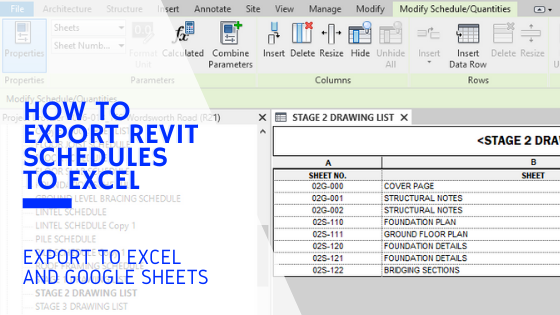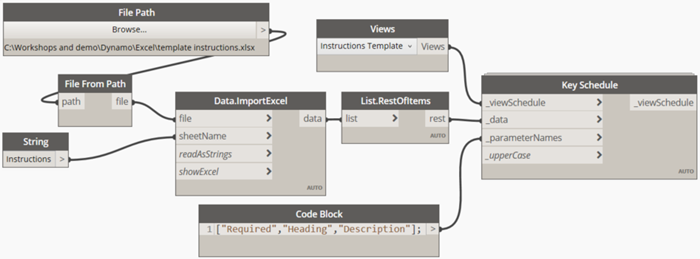Revit Tools: Your Secret to Accuracy and Performance
Wiki Article
Excel-to-Revit: A Game-Changing Process for Architectural Layout - Introducing the Secrets
Presenting excel-to-revit, the game-changing operations that will change your design procedure. With excel-to-revit combination, you can streamline your building design, unlock efficiency, and maximize cooperation within your team. Obtain all set to take your architectural layout to the following degree with excel-to-revit!The Power of Excel-to-Revit Combination

Imagine the ease of having the ability to modify and update project data in Excel, and instantaneously see those modifications mirrored in your Revit model. Say goodbye to hands-on information entrance or tedious updates. With Excel-to-Revit integration, you can save time and decrease errors by leveraging the power of Excel's solutions and features to automatically generate accurate information in Revit.
Not just does this assimilation boost efficiency, however it additionally enhances cooperation amongst employee. You can easily share Excel data with coworkers, who can after that import the information right into their Revit designs. This promotes a seamless exchange of details and ensures that every person is collaborating with the most up-to-date data.

Streamlining Building Layout With Excel-To-Revit
Streamlining architectural design is made easier with using Excel-to-Revit (import excel into revit). With this powerful integration, you can optimize your workflow and conserve useful time throughout the layout process. By leveraging the capabilities of Excel and Revit, you can flawlessly move data in between both systems, removing the demand for hand-operated information entry and lowering the danger of errorsExcel-to-Revit allows you to import and export data easily, allowing you to easily upgrade and modify your architectural styles. You can develop schedules, compute quantities, and create reports in Excel, and after that transfer that information directly into your Revit design. This integration makes sure that your layout details is constantly current and synchronized, removing the need for manual updates and decreasing the opportunities of variances.
By utilizing Excel-to-Revit, you can additionally capitalize on the effective computational capabilities of Excel. You can do intricate computations, evaluate information, and automate repeated jobs, all within Excel. With simply a few clicks, you can import the results back right into Revit, enabling you to make informed design choices and optimize your architectural styles.
Opening Effectiveness: Exploring the Excel-to-Revit Process
Optimize your productivity by perfectly integrating Excel and Revit for a much more effective process. With the Excel-to-Revit workflow, you can open an entire brand-new level of efficiency in your building design process. By utilizing the power of Excel's information administration capabilities and integrating it with the adaptability and accuracy of Revit, you can enhance your design process and conserve valuable time.Among the essential advantages of this combination is the ability to import and export information in between Excel and Revit. This implies that you can quickly transfer job details, such as area routines or material amounts, from one software to the other, eliminating the need for hand-operated information entry and lowering the opportunities of errors. You can likewise create custom solutions and estimations in Excel to automate repeated jobs and execute complex calculations, which can after that be perfectly incorporated into your Revit designs.
Additionally, the Excel-to-Revit process permits for much better coordination and cooperation between employee. With Excel acting as a central data center, numerous employee can work with various elements of the project concurrently, updating and sharing details in real-time. revit tools This not only boosts interaction but additionally makes sure that everyone is collaborating with one of the most current data, removing the threat of inconsistencies.
Taking Full Advantage Of Partnership: Excel-to-Revit for Architectural Teams
By seamlessly integrating Excel and Revit, architectural groups can significantly improve cooperation and accomplish much more effective style end results. When using this powerful process, you can conveniently move data in between Excel spreadsheets and Revit models, improving the design procedure and enhancing communication among group members. With Excel-to-Revit integration, you can effortlessly import task information, such as area timetables, material amounts, and task parameters, directly into Revit, eliminating the demand for manual information entrance and minimizing the chances of mistakes. This seamless connection permits for real-time updates, ensuring that everyone is collaborating with the most updated details and preventing disparities in between various files.Additionally, by leveraging Excel's effective estimation capacities, you can execute complicated computations and analysis on your design data, providing beneficial insights and driving educated decision-making. This assimilation also allows you to export information from Revit to Excel, enabling you to develop detailed reports, graphes, and charts for discussions and evaluation. This collective workflow advertises reliable interaction and sychronisation amongst employee, as Excel acts as a central center for information management and sharing.
Overall, by accepting the Excel-to-Revit process, building groups can attain greater degrees of cooperation, effectiveness, and precision in their design process. revit tools. This integration empowers teams to work with each other perfectly, making certain that everyone is on the exact same web page and adding to the success of the project
Revealing the Tricks of Excel-to-Revit Combination

One of the keys of Excel-to-Revit combination is the capacity to leverage the power of formulas and calculations in Excel to drive parameters and generate complex geometries in Revit. You can link Excel spread sheets to Revit families, enabling you to input information directly into the spreadsheet and have it instantly update in the Revit version. This simplifies the design process and makes sure accuracy and uniformity throughout the task.
An additional secret is the ability to produce personalized timetables and records in Excel, using data drawn out from Revit. This allows you to imagine and evaluate project information in a means that is not possible within Revit alone. You can easily generate quantity take-offs, expense quotes, and job timelines, providing useful insights for decision-making and task monitoring.
Furthermore, Excel-to-Revit assimilation enables effective collaboration amongst group members. Several individuals can work with the same Excel spread sheet at the same time, making it easier to coordinate and track changes. You can also utilize Excel's commenting feature to offer responses or connect design modifications.
Verdict
By incorporating the power of Excel and Revit, designers can now function a lot more efficiently, conserve time, and produce better designs. Beginning integrating excel-to-revit assimilation right into your architectural design procedure today and transform the method you work.With just a few clicks, you can import the results back into Revit, allowing you to make enlightened style choices and optimize your architectural styles.
By utilizing the power of Excel's information administration capabilities and integrating it with the versatility and precision of Revit, you can streamline your layout process and save valuable time.
By seamlessly incorporating Excel and Revit, architectural teams can greatly enhance partnership and attain a lot more effective design outcomes. When utilizing this powerful operations, you can conveniently move data in between Excel spreadsheets and Revit models, simplifying the layout procedure and boosting interaction amongst group members.Additionally, by leveraging Excel's effective computation capacities, you can execute intricate calculations and evaluation on your style data, offering valuable understandings and driving informed decision-making.
Report this wiki page